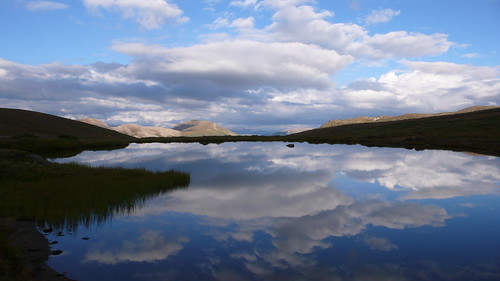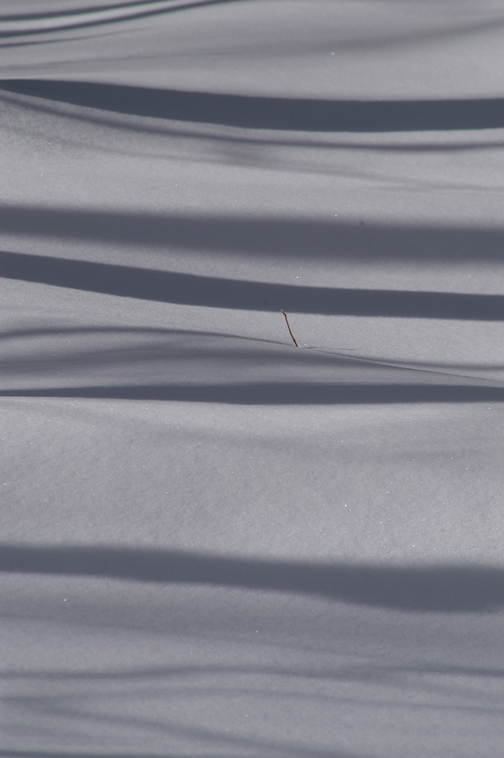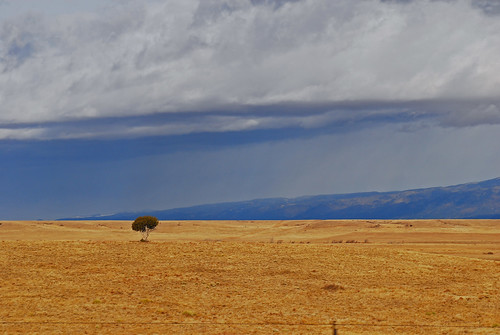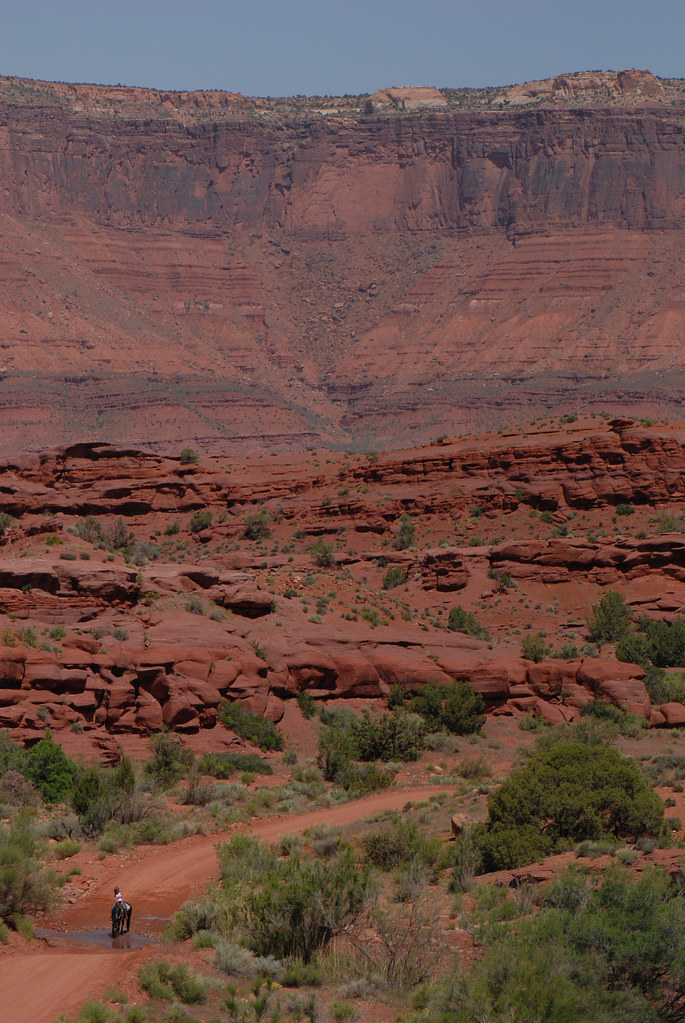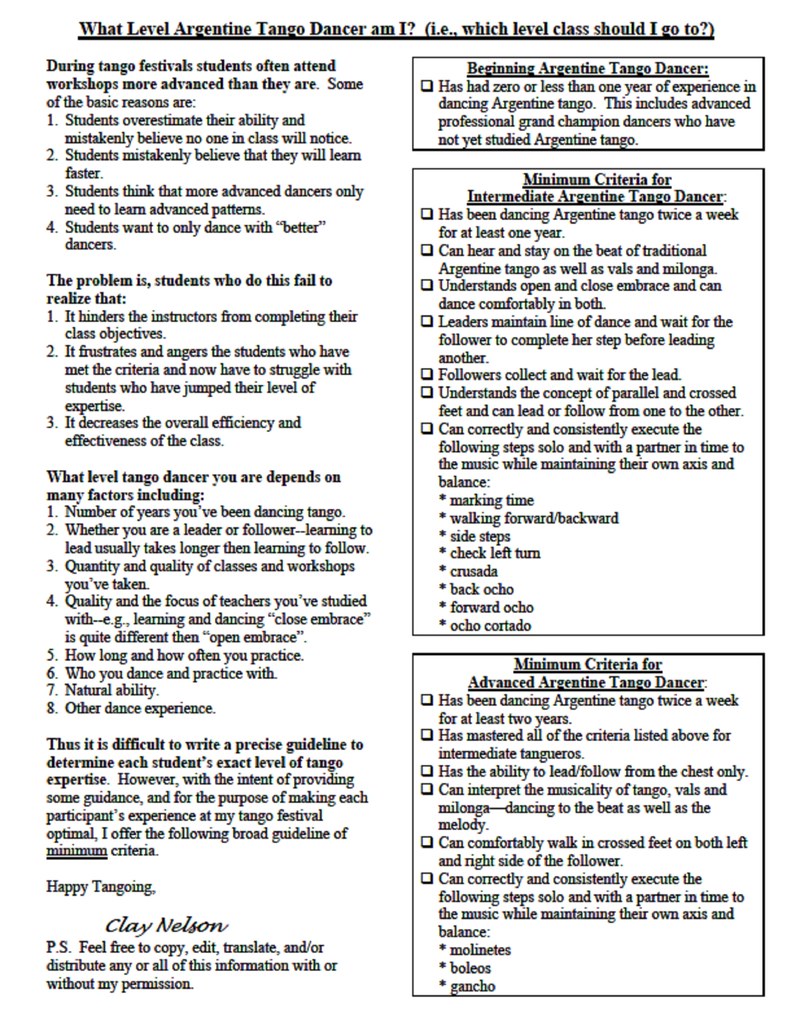I don't trust these fuckers. The only thing making me the least bit comfortable these days is that many of the banks want to re-pay the TARP funds ASAP. If they give the money back, then in theory, they can't be lining their pockets with it.
Here is the article in the New York Times about Geithner's apparently very intimate ties to the big bankers he is charged with overseeing.
Wednesday, April 29, 2009
Tuesday, April 28, 2009
One more time! Turn it up! Milonga!
Adrian y Amanda Costa dancing a milonga to Biagi's "Flor de Monserrat"....
Milonga Otra Vez! Turn it Up!
Javier Rodriguez y Geraldine Rojas dancing to Biagi's "Flor de Monserrat"...
TURN IT UP! Milonga with Oliver Kolker & Luna Palacios
I always liked this one...and what a way to wake up on a Tuesday!
Thursday, April 23, 2009
Tango Short Films
Here's a link to a post of mine from February of 2008. It's all the short films and trailers that I was aware of at the time. There may be more now. If you know of any, please leave a comment and I will add it.
Enjoy.
http://alextangofuego.blogspot.com/2008/02/tango-short-films-clips.html
Enjoy.
http://alextangofuego.blogspot.com/2008/02/tango-short-films-clips.html
Wednesday, April 22, 2009
Monday, April 20, 2009
The Long Emergency :: A book by James Howard Kunstler
This morning, I happened across this on the bookshelves in my office - I bought it a while back, but haven't yet read it. "The Long Emergency - Surviving the End of Oil, Climate Change, and Other Converging Catastrophes of the Twenty-First Century"
"If you give a damn, you should read this book." - THE INDEPENDENT
"This is a frightening and important book." - TIME OUT CHICAGO
"It used to be that only environmentalists and paranoids warned about the world running out of oil and the future it could bring: crashing economies, resource wars, social breakdown, agony at the pump. Not anymore...America's dependence on oil is too pervasive to undo quickly, [Kunstler] warns...In the meantime, we'll have our hands full dealing with...the soaring temperatures, rising sea levels and mega-droughts brought by global climate change. Not long ago, a Jeremiah like Kunstler would have been dismissed as a kook...As brilliant as it is baleful...and we disregard it at our peril." - THE WASHINGTON POST
"What sets The Long Emergency apart...is its comprehensive sweep - its powerful integration of science and technology, economics and finance, international politics and social change, along with a fascinating attempt to peer into a chaotic future. Kunstler is such a compelling and sometimes eloquent writer that it is hard to put the book down." - AMERICAN SCIENTIST
"Funny, irreverent, and blunt." - THE GLOBE AND MAIL
Rolling Stone ::: Article condensed from the book
Books.Google.com
Also note that Kunstler has a new book out - titled "World Made by Hand - A novel of America's post-oil future". I'll have to get my hands on that one.
"If you give a damn, you should read this book." - THE INDEPENDENT
"This is a frightening and important book." - TIME OUT CHICAGO
"It used to be that only environmentalists and paranoids warned about the world running out of oil and the future it could bring: crashing economies, resource wars, social breakdown, agony at the pump. Not anymore...America's dependence on oil is too pervasive to undo quickly, [Kunstler] warns...In the meantime, we'll have our hands full dealing with...the soaring temperatures, rising sea levels and mega-droughts brought by global climate change. Not long ago, a Jeremiah like Kunstler would have been dismissed as a kook...As brilliant as it is baleful...and we disregard it at our peril." - THE WASHINGTON POST
"What sets The Long Emergency apart...is its comprehensive sweep - its powerful integration of science and technology, economics and finance, international politics and social change, along with a fascinating attempt to peer into a chaotic future. Kunstler is such a compelling and sometimes eloquent writer that it is hard to put the book down." - AMERICAN SCIENTIST
"Funny, irreverent, and blunt." - THE GLOBE AND MAIL
Rolling Stone ::: Article condensed from the book
Books.Google.com
Also note that Kunstler has a new book out - titled "World Made by Hand - A novel of America's post-oil future". I'll have to get my hands on that one.
Saturday, April 18, 2009
Ampster's journey :: intricacy of simplicity
Ampster posted a nice one on his journey from ballroom to nuevo to exclusively open embrace and finally to milonguero/close embrace...it's a good read and very insightful...
http://ampstertango.blogspot.com/2009/04/intricacy-of-simplicity.html
http://ampstertango.blogspot.com/2009/04/intricacy-of-simplicity.html
Friday, April 17, 2009
The chalice of my walk

I've been environmentally ranting and raving of late, with not much to say about tango. I'm not dancing socially much anymore, influenced somewhat by choice, somewhat by higher priorities, somewhat by a chock-full social calendar. It's all good. I do miss it, and I don't. I know it will return in good and proper time.
I was sitting here in the morning darkness, CNN muted on the television, determined to find something to write about on the subject of tango. My mind scanned the dancers (leaders) who inspire me, and I remembered Gavito. I pointed out to my self that no one seems to write about him, or hold him up as a model. (I say, I say, self, no one seems to....) I found one of my favorite YouTube videos of him dancing a show with Maria Plazaola and posted it below.
Then I started surfing and searching and googling for a good quote by Gavito to include in this post. I found the quote below on the website/blog 'Tango-E-Vita', an extensive Dutch (but multi-lingual) site, whose proprietor I know nothing about.
"The secret of tango is in this moment of improvisation that happens between step and step. It is to make the impossible thing possible: to dance silence. This is essential to learn in tango, the real dance, that of the silence, of following the melody." [Carlos Gavito]
Continuing to read below the quote on the Tango-E-Vita site I ran across this:
In Argentine tango, walking is philosophy.
The way of walking can emphasize femininity, or masculinity, showing power by military marching, so constructing an identity image, or a dance choreography. Thus, between boots and high heels, the way of walking goes through a whole life spectrum. Meditation is important in the correct understanding of the act. Movement is living motion and immobility is not the absence of movement, it is a knot, a tight cluster of movements. Dancers will realize that both the movement and the awareness, arise and disappear in a moment. They realize that an intention precedes every movement. Intention is the condition for the movement to occur. Mind and body are unsatisfactory because they are always oppressed by new uprisings and disappearings. There is no soul that can control it. Things appear and disappear according to natural law. It is as if organic chemistry cannot be otherwise.
Motion as a form of touch, assumes a line of communication, a haptic listening and responsiveness to the other’s body, and being touched by the music.
Dancers develop this sensitivity in maturity. Mature ballet dancers acquire an attunement to the other that increases their enjoyment of performing. Performing no longer becomes a matter of ‘being seen’, no longer performing an optical illusion in front of the mirror, it also invokes the reciprocity of ‘seeing’, ‘touching’ the other, the audience. An experimental question can be whether the audience also reads through the literal body movements to the underlying desire of the act of dancing. It is the body and its corporeally inscribed memories of movement that offers the embodied self the possibility of rescue from fragmentation. Discovering the inner self through dancing relates directly to body memory, the lived-body. Dancing can be a way of incorporating past into present and maintaining continuity and inner growth. [From Tango-E-Vita]
Motion as a form of touch, walking as a philosophy, walking as a seduction, the art of the walk. Deep stuff. "It is the body and its corporeally inscribed memories of movement that offers the embodied self the possibility of rescue from fragmentation." Really deep stuff.
This all got me thinking about walking. Then, I remembered a thought I had as I DJ'd the final milonga of the Austin Spring Tango Festival a couple of Sundays ago. I noticed that no one was walking. Granted, on the crowded pista, it can be next to impossible, but openings do present themselves to simply walk. Openings on the pista, and openings in the music. I hear the walk in the music, and I must walk. I MUST walk.
In these places in the music where the rhythm says "walk", where the rhythm SHOUTS "WALK ASSHOLE!, I walk, even if it's only two steps. Everyone does not hear the music the same. Everyone does not interpret the music the same. Everyone does not feel the music the same, at the same time. Everyone does not hear "WALK" when I hear and feel it. I suppose it would look pretty silly if everyone broke into a walk at the same time, but I always wonder why I am the only one walking.
As the DJ, I sat and watched at that milonga more than I usually do. I danced maybe two or three tandas, waiting for my favorite songs with my favorite followers. As I watched, I remember thinking that no one was really walking. Again, crowded pista, less opportunity for walking, but those opportunities are still there. Unscientifically, with no quantitative research to back it up, it seems that not many people "just" walk. Am I dreaming this, or is it real? Is it a trend, or an evolution that the tango walk is disappearing?
We almost never see the walk in "performances" at milongas and festivals any more. It's probably too boring for people to watch two dancers getting into the music, getting into their connection, getting into each other, simply walking. Detlef y Melina walk. Ney y Jennifer walk. Javier Rodriguez walks. Gustavo Naveira most definitely walks. Osvaldo Zotto walks. The milongueros walk. The young bucks aren't walking much it seems.
As we all know, the tango walk is the most difficult aspect of tango to learn, and to teach. It is both the most difficult to learn, and takes the most time to learn. I think it took me three years, maybe two-and-a-half, to "get my walk". But it's important to note, that while I "got it", I still don't "have it". It's like a silver chalice compared to the fucked-up, paper Dixie Cup walk I walked with for those many months. The chalice of my walk is tarnished, and it still has a long way to go. I don't drink from the chalice much, and it needs to be used and polished on a regular basis. Someday, in many more years, the chalice of my walk will hopefully become a gilded, bejeweled chalice. Worn and dented, tarnished in the deep grooves of the detail, missing a jewel or two, but polished from use in other areas, and with an unmistakable patina of age and experience and beauty. Some day. Perhaps. In my dreams.
Methinks it is the difficulty of the walk that few dance it. They give up too soon. Methinks this may be, quite possibly, the reason the new, young dancers (and a few old farts) are sliding into nuevo, abandoning Argentine tango in whole or in part. Who knows? I don't want to start that debate again, but those who know me know how I feel about the subject. Last night I responded to a discussion thread on the new 'ning' dealy-bopper 'Tango Connections' about "the most important things" to teach beginners. One respondent talked of the importance of teaching the basic 8. I responded that I purposely avoid and never mention, and definitely do not teach the basic 8. There are too many leaders dancing the basic 8 socially, back step and all. Plus, the basic 8 is totally unnecessary as a teaching tool, or as dancing vocabulary. In my classes, I focus on the walk, the walk, the walk. I drill it in each week (both lead and follow technique) before presenting new material. So far, they keep coming back for more.
With a solid walk, the other "stuff" comes easier. With a solid walk, you can connect and enjoy and feel good about your tango progress. With a solid walk, you can walk an entire dance. Some songs lend themselves to walking - "walking songs" I call them - how original. I'll never forget the first time I got the balls to walk an entire song. It was at a practica, and DiSarli's Verdemar came on (of course, it was me dj'ing). After walking the dance, she said, "it's so nice to dance with someone who has the balls to 'just' walk...". I've been complimented on long walks in other dances at other milongas. The dance becomes more about the connection, the "stuff" is inconsequential to the point of not noticing that it isn't there. The follower can relax, even rest for a time, in my embrace. She really doesn't have to think and can lose herself in the chalice of my walk.
The best of luck to all of you in 'finding' your walk.
Lastly, the Tango-E-Vita site has a great page devoted to the walk. I'm going to go back and read it myself.
Carlos Gavito y Maria Plazaola :: Milonga a Gavito
Gustavo Naveira y Giselle Anne :: Solo Caminadas en clase
(to Di Sarli's Verdemar, in an Atlanta workshop I attended a couple of summers ago...still one of my inspirations)
http://www.youtube.com/watch?v=LgnjOZxVsCw
Osvaldo Zotto y Lorena Ermocida :: Confiteria Ideal :: Indio Manso
My apologies for posting these same videos (posted many times before), but they remain my "walking" inspiration...
Wednesday, April 15, 2009
On Design :: What is our intention as a species?
Here's a TED talk from Architect William McDonough on infinite, or cradle-to-cradle design. In it, he says the "design strategy" for humanity should be this:
"Our goal is a delightfully diverse, safe, healthy and just world, with clean air, water, soil and power - economically, equitably, ecologically and elegantly enjoyed."
Sounds good to me.
I had heard something about China burning up ALL their coal and using ALL their topsoil, simply to produce (clay) bricks build shelter to house their growing population.
I guess this is where it came from. It looks like McDonough and his team have developed and implemented a viable workaround - and moved the farm land to the roofs of the city.
It appears some of us are moving in the right direction, we just need to pick up the pace.
"Our goal is a delightfully diverse, safe, healthy and just world, with clean air, water, soil and power - economically, equitably, ecologically and elegantly enjoyed."
Sounds good to me.
I had heard something about China burning up ALL their coal and using ALL their topsoil, simply to produce (clay) bricks build shelter to house their growing population.
I guess this is where it came from. It looks like McDonough and his team have developed and implemented a viable workaround - and moved the farm land to the roofs of the city.
It appears some of us are moving in the right direction, we just need to pick up the pace.
Tuesday, April 14, 2009
The criminalization of seed banking: hidden inside Monsanto "food safety" bills
Write to your folks in Congress to express your opposition to these bills.
http://www.opednews.com/articles/The-criminalization-of-see-by-Linn-Cohen-Cole-090301-82.html
http://www.opednews.com/articles/The-criminalization-of-see-by-Linn-Cohen-Cole-090301-82.html
Sunday, April 12, 2009
The Great Correction :: Renovatio
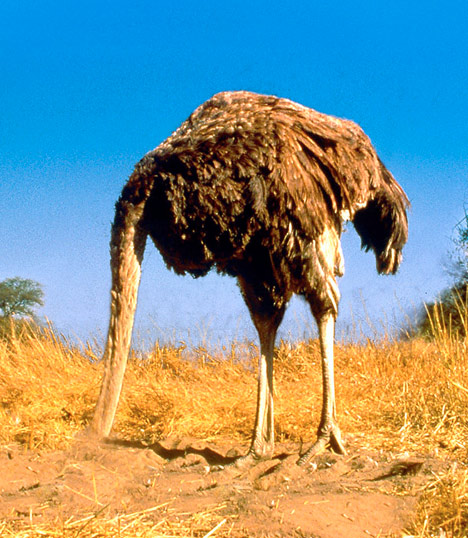
The Great Correction, as in the inverse of the Great Depression, as in "course correction", as in "paradigm shift". I'm still on the subject of the Vanity Fair (April 2009) article "Rethinking the American Dream", written by David Kamp.
I've finished reading the article, and I cannot express how important I think this piece is. Every man and woman and young adult aged 16 and over should read this article and begin talking about it on a daily basis.
It is only through acknowledging that a problem exists - a very large scale problem in the way we Americans think - and then talking about potential solutions to the problem, can we begin to solve it.
Here is another excerpt from the article that is a verbatim account of what I have been telling my closest friends (and ex-wives) for thirty years now - that the American Dream is flawed in its view that in each successive year, life should be better. Better job; or same job only better; more money; better car; better house; or better the current house; better vacations; better toys; better kitchen faucet; better, fancier, more provincial door mat. Better, more, faster. Each quarter, each fiscal or calendar year, each generation, we kids and our kids and their kids. More is never enough.
It is our current and trending catastrophic reality that we live in a finite world with finite resources. We are currently banging up against the inevitable ceiling of those limitations in the basic building blocks of life - water, food, shelter. The basic premises of the problem are that we are simultaneously over-populated and under-resourced. In a word, unsustainable. Our current way of life is not sustainable in the long term.
I repeat, our current way of life is not sustainable in the long term.
We all know this to be true.
Most of us are deluding ourselves that in a year or two, things will be back to "normal", and that we can go on in our individual pursuits of the American Dream - building wealth, gaining assets or at least equity. I believe that the old, resource hogging, unsustainable way of life is gone forever. I may be offering this on the leading edge of this new wave, this paradigm shift, five or ten or fifteen years too early, but the change is coming. The time to change, or at least to begin the process of change, is now. The time to acknowledge that there is a problem is now. We can no longer afford to keep our heads in the proverbial sand.
Many of us are thinking it. We have been feeling it for five or ten or fifteen years or longer. People are (or were) more successful, but are more stressed out and less happy. But everyone is afraid to talk about it. There is a fear of being branded un-American or un-patriotic or downright crazy. Let's get it out in the open and start dealing with it in a positive, proactive, forward thinking way.
Let's reinvent the wheel. Think outside the box? B.S. There is no box anymore. Think, and so shall ye be. Supposedly Jesus said that. We all need to think about how it can be. How it wants to be. How it should be. Not just re-think, but completely reinvent the American Dream. The New American Dream. A new way of life for the new century, starting with us, but for the entire planet. We need to manifest a new reality.
We put men on the moon and sent exploratory vehicles to Mars and beyond. We uncovered the secret of the atom and the quark. Decoding DNA, cellular biology and cures for diseases, and on and on. We are capable of great things. Obviously, in the past we have screwed the pooch in many, many ways. I would offer that when it is in the pursuit of profit and self-interest (or national interest), it always backfires on us. I would offer that when it is motivated by love and the common good and what is right, it can never fail. We can do this.
It should not be based on profit. It should be based on love, compassion and understanding. It should be based on the common good. It should be based on (from the article) the "freedom from want, not the freedom to want". It should be based on sustainability. It should be based on technological innovation and good science. It should be based on social responsibility to our fellow man and to our planet both. I am confident we can reinvent our civilization. It may take one hundred years, or more, but I am confident and hopeful that intelligence and love can triumph over ignorance and ignoring the problem because it is the comfortable thing to do. I am confident. I am full of hope. We don't have a choice. This has to be done. Starting now.
It's interesting that this all gelled for me on this day of renewal and rebirth - Easter Sunday 2009. I have to admit I wasn't paying attention during Easter services at St. Mark's today. (I go to church once or twice a year...) I was daydreaming, looking up at the flying buttresses and delicate arches and fine millwork, hand-hewn from walnut timber by German craftsmen in 1870 or so. I was gazing at the intricacies and vibrant color of the stained glass windows and contemplating the beauty of what man can accomplish in this world. When I awoke from my tampiquen~a and cheese enchilada induced two-hour Sunday afternoon nap, my sweetie and I threw the rubber stick to the dog. I finished reading the article, and then started this post - it is probably the fastest I have ever written a post of any merit. I had to get this out. Forgive me in advance if it's dis-jointed or generally funky prose. It flew off my fingertips as it spilled from my heart and mind - largely unedited but for a few typos.
Renovatio - Latin for "rebirth". "Renovatio", or "The New American Dream"? I'm trying to think of a name for a new blog. "The Great Correction"? Suggestions are welcome.
Oh, here is that excerpt:
"And what about the outmoded proposition that each successive generation in the United States must live better than the one that preceded it? While this idea is still crucial to families struggling in poverty and to immigrants who've arrived here in search of a better life than that they left behind, it's no longer applicable to an American middle class that lives more comfortably than any version that came before it. (Was this not one of the cautionary messages of the most thoughtful movie of 2008, WALL-E?) I'm no champion of downward mobility, but the time has come to consider the idea of simple continuity: the perpetuation of a contented, sustainable middle-class way of life, where the standard of living remains happily constant from one generation to the next."
Stealing Ghandi's words, we must BE the change we wish to see in the world. We must BE the example for all humanity. We must walk the talk. We must. We must.
Here is the link to the article again: http://www.vanityfair.com/culture/features/2009/04/american-dream200904 Please read it. Please forward it to everyone you know and ask them to forward it to everyone they know. This really needs to become the new national dialog. Please, please purty please.
Lastly, credit where credit is due. "The Great Correction" came from Eliza Gilkyson's song of the same name. But the real credit goes to my cool, hip, girlfriend who immediately told me about the song when I was struggling with the words for what to call this post. She is my inspiration and my muse.
Lyrics here:
down on the corner of ruin and grace
I’m growin weary of the human race
hold my lamp up in everyone’s face
lookin for an honest man
everyone tied to the turnin wheel
everyone hidin from the things they feel
well the truth’s so hard it just don’t seem real
the shadow across this land
people round here don’t know what it means
to suffer at the hands of our american dreams
they turn their backs on the grisly scenes
traced to the privileged sons
they got their god they got their guns
got their armies and the chosen ones
but we’ll all be burnin in the same big sun
when the great correction comes
down through the ages lovers of the mystery
been sayin people let your love light shine
poets and sages all throughout history
say the light burns brightest in the darkest times
it’s the bitter end we’ve come down to
the eye of the needle that we gotta get through
but the end could be the start of something new
when the great correction comes
down through the ages….
down to the wire runnin out of time
still got hope in this heart of mine
but the future waits on the horizon line
for our daughters and our sons
I don’t know where this train’s bound
whole lotta people tryin to turn it around
gonna shout til the walls come tumblin down
and the great correction comes
don’t let me down
when the great correction comes
Video here:
Saturday, April 11, 2009
Rethinking the American Dream :: A must read recommendation
On Wednesday, I wrote about the article "Rethinking the American Dream" in the April issue of Vanity Fair. I'm laying here this morning, continuing to read, with a fluorescent yellow "Fannie Mae" logo'd pen in hand, and noticed that I am essentially highlighting entire pages.
Needless to say, this is a "must read" article. By the way, I hate it when I say (or write) "needless to say". It's like I'm saying, "I know I don't need to say this, but I'm going to go ahead and say it anyway." Even though it's obvious that I DO need to say it. Strange thing this English language. Strangely beautiful.
Here's the excerpt that caused me to stop reading the article and write this post:
Still, the American Dream, in F.D.R.'s day, remained largely a set of deeply held ideals rather than a checklist of goals or entitlements. When Henry Luce published his famous essay "The American Century" in LIFE magazine in February 1941, he urged that the U.S. should no longer remain on the sidelines of World War II but use its might to promote this country's "love of freedom, a feeling for the equality of opportunity, a tradition of self-reliance and independence and also of cooperation." Luce was essentially proposing that the American Dream - more or less as Adams [James Truslow Adams, author of The Epic of America] had articulated it - serve as a global advertisement for our way of life, one to which non-democracies should be converted, whether by force or gentle coercion. (He was a missionary's son.)
I sit here, struck by the notion that we all know the American Dream goes beyond our materialistic tendencies and full blown desires - "the grim smell of want". It goes beyond "the better and fuller and richer life" ideal. It goes beyond equality and freedom and democracy. We, the American people, through our government, have used the American Dream as a gentle, subliminal weapon against governments and societies who choose not to ascribe to the American way of life. Actually, most times not so gentle and subliminal.
It's as if we collectively 'infer' to these nations and cultures that in two hundred years, we have found that our way is the best way of life, and we'd like for them to adopt it. Or else. And it's not just our government doing this on our behalf. It is also the profit motivated multi-national corporation, big oil, and all the other big resource rapists - whether those resources be natural or human. Talk about passive aggressive!
I would have to disagree with Obama in his assertions last week in Europe that Americans are not arrogant. Our apathy and ignorance of these truths are indicators of our arrogance. These truths - that we are fucking up our world with our way of thinking. Thinking that is overwhelmingly influenced by the capitalist profit motive.
I'm sorry, but this American Dream has evolved into a very bad thing over the past 100 years.
No. I take that back. I'm not sorry. I'm not sorry to be saying this. I'm not against the concept of the American Dream, I just think it's time we re-define what it is. Re-define it into something sustainable and healthy for man and beast and culture and nation and mother earth.
For thirty plus years now, my concern for this earth has not been the one billion of us living in the industrialized first world. It is the remaining five billion in the second and third worlds who aspire to the American way of life. A roof over their heads. Purified running water. Electricity. Schools. Books. Roads. Cars. Grocery stores. Wal-Marts. A Home Depot or a Lowe's every ten miles. Aquifer draining center-pivot irrigation. John Deere combine tractors. Petrochemical based fertilizers and pesticides. You get my drift.
If one billion of us have fucked things up in less than one hundred years, what do you think will happen as the other five billion start to come online as resource consumers in the next one hundred years. We are already hitting the upper limits of what the earth and her beautifully, perfectly balanced systems can handle.
The beautiful American Dream has been transformed into a nightmare. A nightmare for the entire planet.
Like it or not, we have become worldwide missionaries of the Dollar. Our God, the Dollar, who art in heaven. Thy kingdom come, Thy will be done, On earth as it is in these United States of America. Give us this day our daily debts. And forgive us our trespasses in the pursuit of material wealth, as we forgive those who trespass against us in their own profit taking. And lead us not into the temptation to stray from the American way. But deliver us from an evil, un-American, un-patriotic life based on love and compassion and understanding. For thine is the kingdom, the power and the glory. For ever and ever. Amen. Praise be to our God, the Dollar Almighty.
Happy Easter.
P.S. Don't worry about my blasphemy, or is it full blown sacrilege? Tomorrow, I'll be going to Easter services with the family at St. Mark's Episcopal Church in San Antonio. Holy Communion should cleanse my soul. My God understands me.
Needless to say, this is a "must read" article. By the way, I hate it when I say (or write) "needless to say". It's like I'm saying, "I know I don't need to say this, but I'm going to go ahead and say it anyway." Even though it's obvious that I DO need to say it. Strange thing this English language. Strangely beautiful.
Here's the excerpt that caused me to stop reading the article and write this post:
Still, the American Dream, in F.D.R.'s day, remained largely a set of deeply held ideals rather than a checklist of goals or entitlements. When Henry Luce published his famous essay "The American Century" in LIFE magazine in February 1941, he urged that the U.S. should no longer remain on the sidelines of World War II but use its might to promote this country's "love of freedom, a feeling for the equality of opportunity, a tradition of self-reliance and independence and also of cooperation." Luce was essentially proposing that the American Dream - more or less as Adams [James Truslow Adams, author of The Epic of America] had articulated it - serve as a global advertisement for our way of life, one to which non-democracies should be converted, whether by force or gentle coercion. (He was a missionary's son.)
I sit here, struck by the notion that we all know the American Dream goes beyond our materialistic tendencies and full blown desires - "the grim smell of want". It goes beyond "the better and fuller and richer life" ideal. It goes beyond equality and freedom and democracy. We, the American people, through our government, have used the American Dream as a gentle, subliminal weapon against governments and societies who choose not to ascribe to the American way of life. Actually, most times not so gentle and subliminal.
It's as if we collectively 'infer' to these nations and cultures that in two hundred years, we have found that our way is the best way of life, and we'd like for them to adopt it. Or else. And it's not just our government doing this on our behalf. It is also the profit motivated multi-national corporation, big oil, and all the other big resource rapists - whether those resources be natural or human. Talk about passive aggressive!
I would have to disagree with Obama in his assertions last week in Europe that Americans are not arrogant. Our apathy and ignorance of these truths are indicators of our arrogance. These truths - that we are fucking up our world with our way of thinking. Thinking that is overwhelmingly influenced by the capitalist profit motive.
I'm sorry, but this American Dream has evolved into a very bad thing over the past 100 years.
No. I take that back. I'm not sorry. I'm not sorry to be saying this. I'm not against the concept of the American Dream, I just think it's time we re-define what it is. Re-define it into something sustainable and healthy for man and beast and culture and nation and mother earth.
For thirty plus years now, my concern for this earth has not been the one billion of us living in the industrialized first world. It is the remaining five billion in the second and third worlds who aspire to the American way of life. A roof over their heads. Purified running water. Electricity. Schools. Books. Roads. Cars. Grocery stores. Wal-Marts. A Home Depot or a Lowe's every ten miles. Aquifer draining center-pivot irrigation. John Deere combine tractors. Petrochemical based fertilizers and pesticides. You get my drift.
If one billion of us have fucked things up in less than one hundred years, what do you think will happen as the other five billion start to come online as resource consumers in the next one hundred years. We are already hitting the upper limits of what the earth and her beautifully, perfectly balanced systems can handle.
The beautiful American Dream has been transformed into a nightmare. A nightmare for the entire planet.
Like it or not, we have become worldwide missionaries of the Dollar. Our God, the Dollar, who art in heaven. Thy kingdom come, Thy will be done, On earth as it is in these United States of America. Give us this day our daily debts. And forgive us our trespasses in the pursuit of material wealth, as we forgive those who trespass against us in their own profit taking. And lead us not into the temptation to stray from the American way. But deliver us from an evil, un-American, un-patriotic life based on love and compassion and understanding. For thine is the kingdom, the power and the glory. For ever and ever. Amen. Praise be to our God, the Dollar Almighty.
Happy Easter.
P.S. Don't worry about my blasphemy, or is it full blown sacrilege? Tomorrow, I'll be going to Easter services with the family at St. Mark's Episcopal Church in San Antonio. Holy Communion should cleanse my soul. My God understands me.
Friday, April 10, 2009
The Earth is flat and Argentine Tango evolved...
The Earth is flat, global warming is imaginary, and Argentine Tango evolved in the U.S. in the 1950's as a result of foxtrot, waltz, two-step and 'whatever' dancers who couldn't figure out the steps to these dances and "improvised" Argentine Tango into existence.
The writer claims the origins of Argentine Tango can't be 'proven'. I don't have the expletives in my vocabulary to express myself after reading this.
Gotta go...heading into town to a milonga...
The writer claims the origins of Argentine Tango can't be 'proven'. I don't have the expletives in my vocabulary to express myself after reading this.
Gotta go...heading into town to a milonga...
Thursday, April 9, 2009
What Level Tango Dancer Am I?
Wednesday, April 8, 2009
The American Dream in Reverse
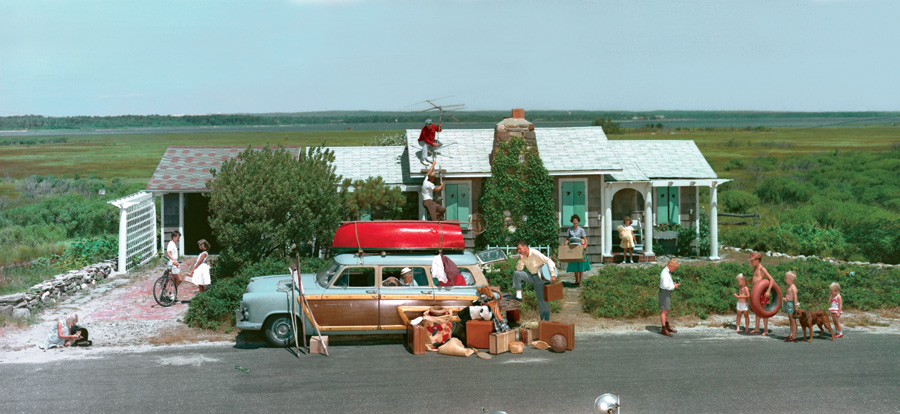
[Closing a Summer Cottage, Quogue, New York, a 1957 Norman Rockwell art-directed Colorama by Ralph Amdursky and Charles Baker. © 2009 Kodak, courtesy of George Eastman House. The photographs in this article are Kodak Coloramas that were exhibited at New York’s Grand Central Terminal from 1950 to 1990. ]
The article in the April Vanity Fair is actually titled "Rethinking the American Dream" [David Kamp, Author]. I missed Obama's assertion in his inaugural address that what we are all currently experiencing is "the American Dream in reverse". Kamp also quotes Moss Hart, a playwright from the days of the Depression - "the grim smell of actual want was always at the tip of my nose...".
The grim smell of actual want. What is it about that phrase? As I sit here in bed writing this post, I'm at a loss for the words to express the emotions that it dredges up from the deep, dank, dark recesses of my mind.
I'm still reading the article, so I don't have much to say yet.
Here is the online version of the article if you care to read it. Come back and comment. I would love to hear everyone thoughts.
Finally, thanks to Nancy for alerting me to the article last month.
Sunday, April 5, 2009
Sunday Morning :: Big Tobacco Tax
I'm sitting here watching CNN before the CBS Sunday Morning Show starts and there's a bit about the new sixty-two cent per pack tax on cigarettes. I haven't done any looking into it, as far as the logic behind the tax and where the money is intended to go. The key word here is "intended". Theoretically, it would go to cover the skewed medical costs for tobacco users. We all know how our governments don't work as intended. It wouldn't surprise me if the tax actually goes back to the tobacco growers (through the Department of Agriculture) for research into how to grow healthier, more pest and drought resistant tobacco plants. I know, that's a stretch, but you get my drift.
The reporter said tobacco kills 400,000 people in the U.S. a year. I looked it up once and was surprised to find that one in four smoke. So that's seventy-five million [75,000,000] current, living smokers. So it kills 400k every year - lung cancer, throat cancer, mouth cancer, tongue cancer, lip cancer, arteriosclerosis, emphysema, hypertension, myocardial infarction, and on and on. 400k a year dead, I would guess five times that number of smokers who are seriously sickened in some way by it - perhaps 2,000,000 each year. Just call it 2,500,000 each year - which seems way too low based on 75 million smokers.
So let's do the math. Let's say at least $100k each for the 400k who permanently quit smoking. I think my dad's final bill was around $300k. That's $40,000,000,000 into the health care system for them. For the other 2.1 million folks, let's say ten grand for each of them. That's another twenty billion. $60 bil total. I'm guessing that's a low estimate. Let's round up to $100bil.
75mil smokers at a pack a day - three hundred sixty five days a year - that's twenty-seven billion, three hundred seventy-five million packs of cigarettes a year.
Divide $100bil in health care costs to the system each year by 23,375,000,000 packs a year and you get $3.65 per pack for the smoker to cover his or her own health care costs. Looks to me like we need to increase that tax by three bucks a pack. And that little quick and dirty math doesn't take into account the adverse health effects for all those subjected to second hand smoke.
The addictive product in a capitalist system. It might be the perfect product if it didn't kill the consumer in the end. But with twenty or thirty years of addiction, big tobacco is still doing pretty well on the balance sheet. Very well.
One parting thought - this doesn't take into account the rest of the world, where perhaps 50% or more of the population smokes. This is going to sound extreme, but I think I've just convinced myself we need tobacco as a population controller. I may actually be against increased taxation of tobacco. Hmmm. I didn't expect that.
The reporter said tobacco kills 400,000 people in the U.S. a year. I looked it up once and was surprised to find that one in four smoke. So that's seventy-five million [75,000,000] current, living smokers. So it kills 400k every year - lung cancer, throat cancer, mouth cancer, tongue cancer, lip cancer, arteriosclerosis, emphysema, hypertension, myocardial infarction, and on and on. 400k a year dead, I would guess five times that number of smokers who are seriously sickened in some way by it - perhaps 2,000,000 each year. Just call it 2,500,000 each year - which seems way too low based on 75 million smokers.
So let's do the math. Let's say at least $100k each for the 400k who permanently quit smoking. I think my dad's final bill was around $300k. That's $40,000,000,000 into the health care system for them. For the other 2.1 million folks, let's say ten grand for each of them. That's another twenty billion. $60 bil total. I'm guessing that's a low estimate. Let's round up to $100bil.
75mil smokers at a pack a day - three hundred sixty five days a year - that's twenty-seven billion, three hundred seventy-five million packs of cigarettes a year.
Divide $100bil in health care costs to the system each year by 23,375,000,000 packs a year and you get $3.65 per pack for the smoker to cover his or her own health care costs. Looks to me like we need to increase that tax by three bucks a pack. And that little quick and dirty math doesn't take into account the adverse health effects for all those subjected to second hand smoke.
The addictive product in a capitalist system. It might be the perfect product if it didn't kill the consumer in the end. But with twenty or thirty years of addiction, big tobacco is still doing pretty well on the balance sheet. Very well.
One parting thought - this doesn't take into account the rest of the world, where perhaps 50% or more of the population smokes. This is going to sound extreme, but I think I've just convinced myself we need tobacco as a population controller. I may actually be against increased taxation of tobacco. Hmmm. I didn't expect that.
Saturday, April 4, 2009
Happiness Incarnate
A great find from my friend Rigoberto...
Shit. Now I'm crying. I hate it when that happens.
Under "related" videos...here is a milonga in the same location...
http://www.youtube.com/watch?v=q1J6W_CB6w8
Shit. Now I'm crying. I hate it when that happens.
Under "related" videos...here is a milonga in the same location...
http://www.youtube.com/watch?v=q1J6W_CB6w8
Subscribe to:
Comments (Atom)

